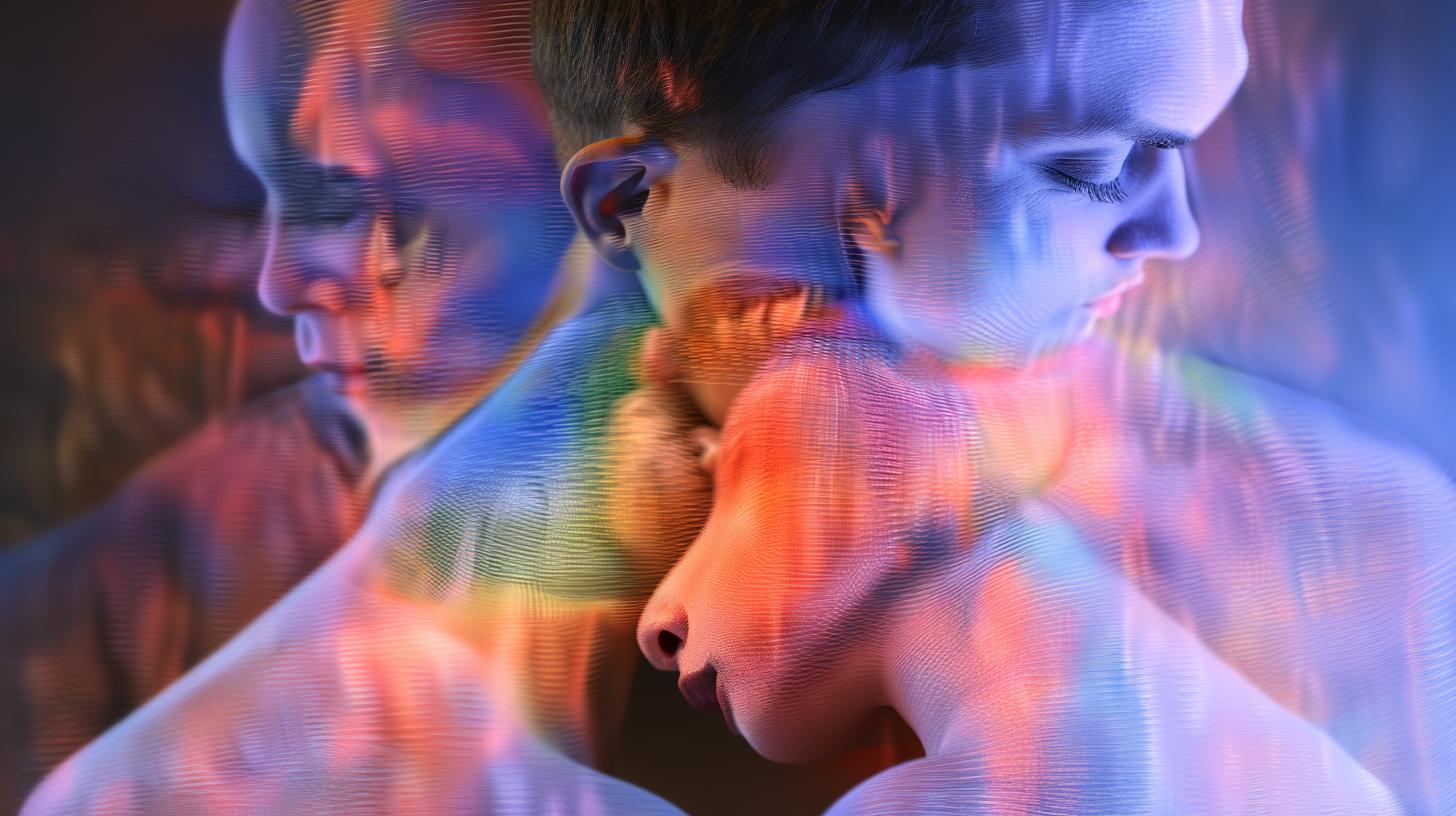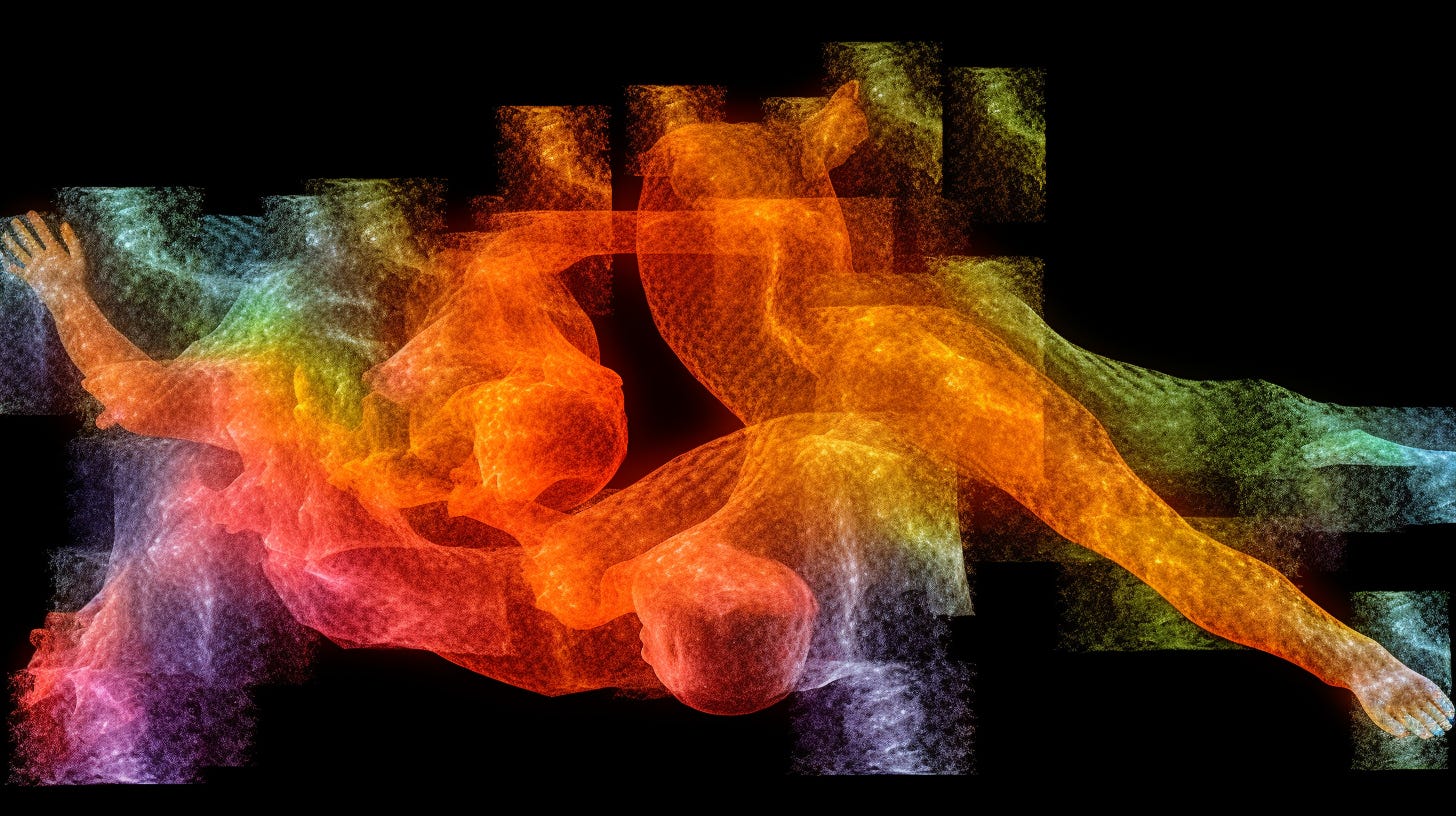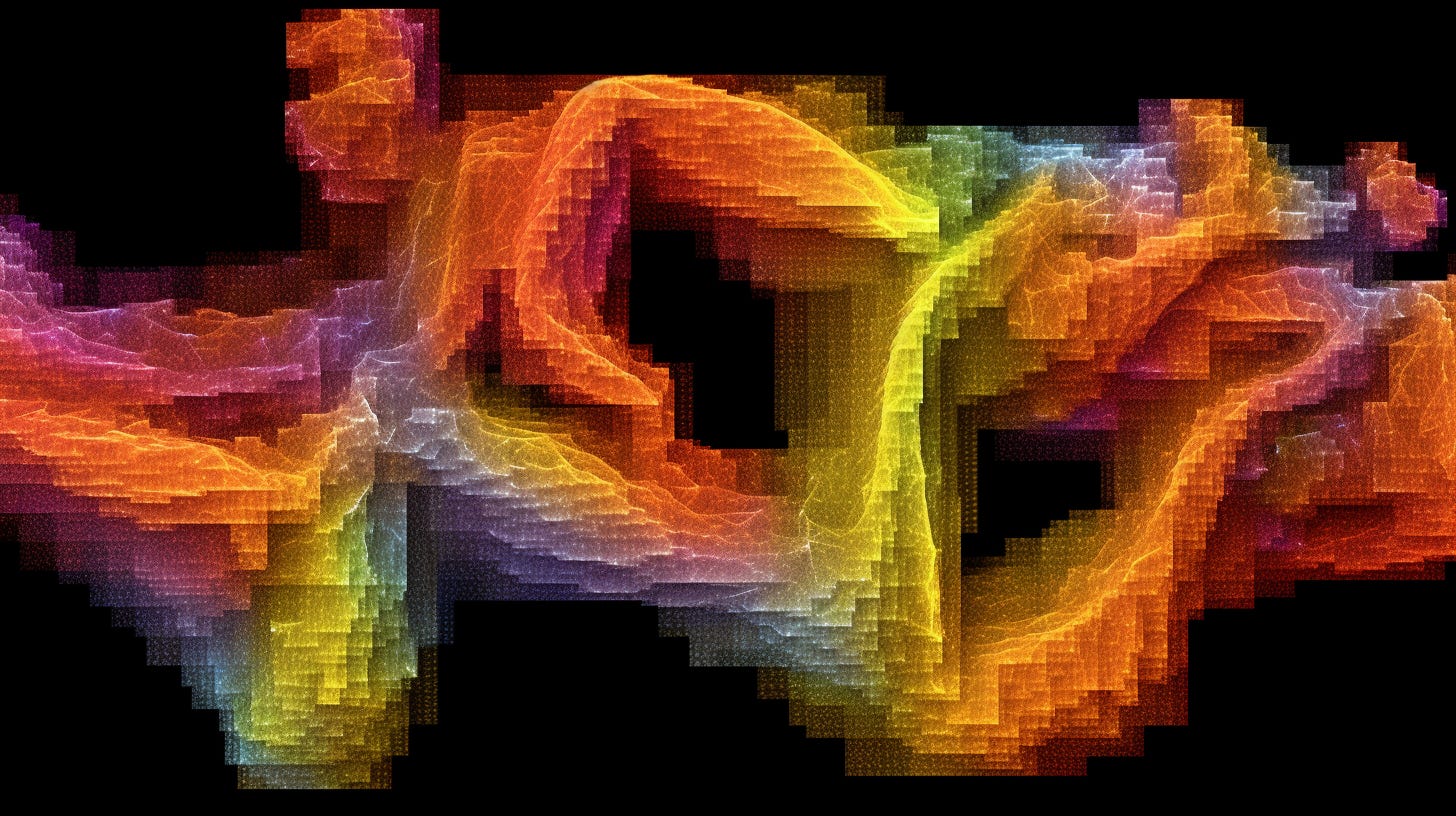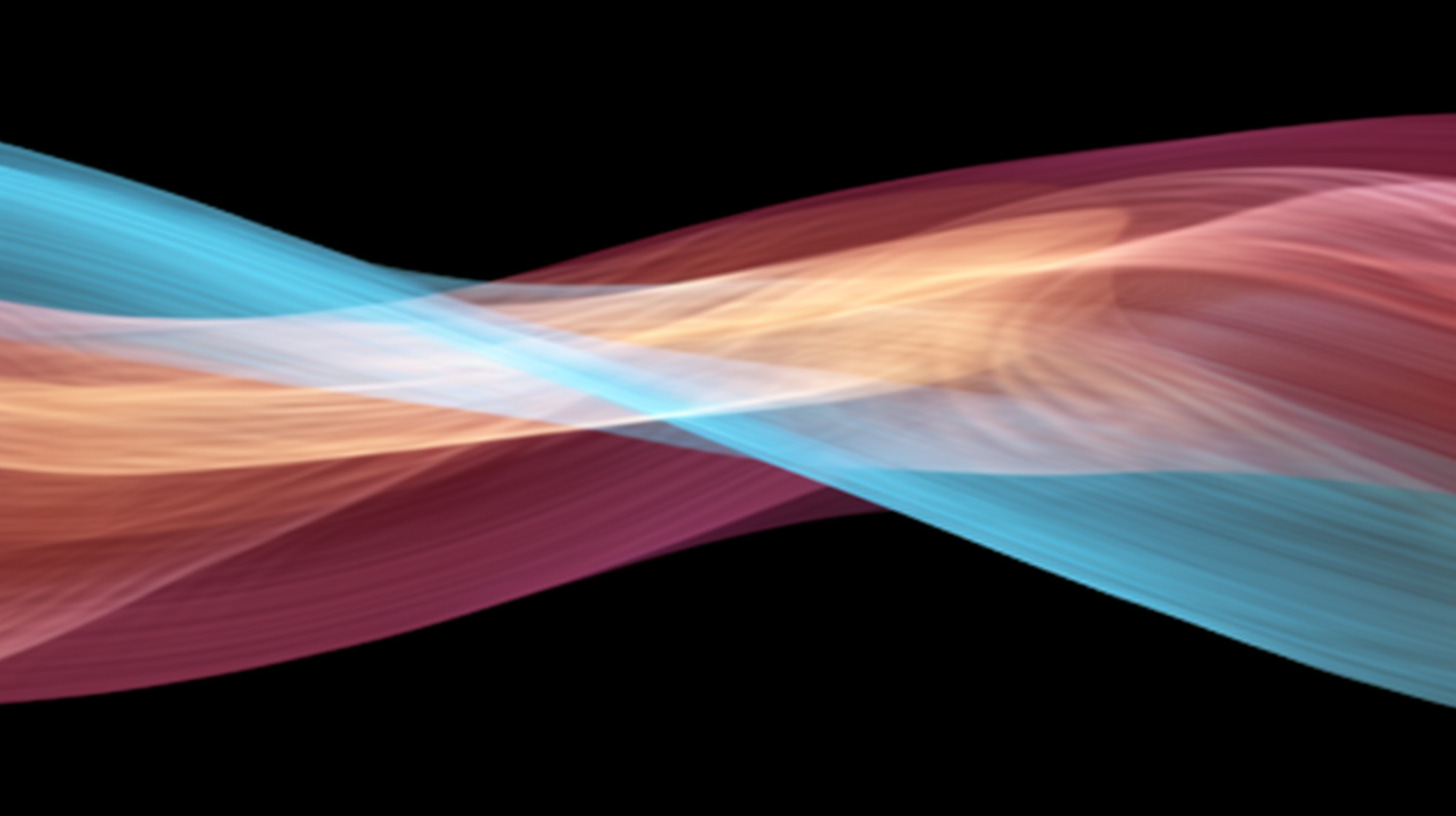Dancing About Network Architecture
Psychic Surgery for the Disembodied Interface

One of the many foolish things about the fools who compare writing about music to dancing about architecture is that dancing usually is about architecture. When bodies move in relation to a designed space, be it stage or ballroom or living room or gymnasium or agora or Congo Square, they comment on that space —whether they mean to or not.
- Tiarney Miekus
I haven’t always had an intuitive relationship with my body. For the first 20 years of having it, I leaned into the cerebral side of mind-body split, finding intellectual retreat a reprieve from physical exposure to the world. It was deeply unsatisfying: a retreat from the body is a retreat from presence to the self, which is a requirement for being present to anything at all. The head is an infinite, but isolating space.
Then I started running, first as a way of tiring out my anxieties — I started in college but began running earnestly while living in Japan. There, my body was unavoidable: my skin, my size, my gender, all flagged me for comment. A limited Japanese vocabulary gave my body more presence than my words ever could.
Years ago, I had a conversation with Sarah Kenderdine, who was tasked with preserving the “intangible cultural heritage” of Kung Fu for a digital exhibition. Kung Fu is an embodied cultural practice, gestures and movements entwined with the influences of social geography. The body/mind divide is also embedded into the way we engage with machines, and Kenderdine was the first person I’d encountered who was working with digital media to preserve the “intangible” knowledge embedded into the movement of bodies.
I’ve been pondering that tension ever since: on the one hand, the interiority of physical experience, the raw material of whatever we convey. On the other hand, the data that enters systems, built exclusively on what can be observed and measured.
Today, information management in digital systems is designed on the back of a heavy assumption. It suggests that information, despite being transformed into data and transmitted through patterns of symbols and noise, can nonetheless keep its most essential character. Loss is assumed, but nearly always considered acceptable, and information is more often than not treated as “complete.”
But at its core, communication over any distance is based on stripping information away from its physical origins and webs of qualifiers and contextualizing details. Even the motions of the tongue get lost when we move words over text, adding ambiguity in the absence of tone and emphasis that mere italics can only tease at.
Without a signal, a thing can’t be measured. Data science grapples with this all the time: we can’t measure the intangible, so we find proxies. Things stand in for presence, or bodies. We can’t tell if you are happy, but we can tell if you are smiling. In the reductive world of facial recognition, then, all smiles are quantified as happiness. But what is observed is often at odds with what is experienced. The polite smile, the unsafe smile, the smile that emerges when frustration hits a breaking point: the inner experience of the world is missing from digital systems.
Digital information is designed to eliminate the need for bodies. Information moves like a ghost: disembodied, but tasked with action. Yet, information is deeply rooted in the body. The body shapes the reception and transmission of ideas. It generates information that engages with the senses of others.
To call this a tension between analog and digital would be inaccurate. The difference of digital technology is a tension between embodiment and disembodiment: presence, and remove. It is a philosophical problem, but we ignore it in the design of media systems at our own peril.
When we design, we build these assumptions about presence into the things we make. When we don’t engage with the ghostly disembodiment of information, perhaps we build things that amplify distance and disconnection. Things that favor our ghosts over our presence.

Choreodaemonics
In July I engaged in a week-long conversation, best described as a conceptual design process. It was an opportunity to question assumptions of the design process centered on accessible physical experiences. At the same time, it was modeling a kind of alignment question, surfacing key ideas and distinctions from a community of dancers and thinkers. The event was held at Brown University, and organized by Laurel Lawson and Sydney Skybetter.
Choreodaemonics — the working title — was multidisciplinary toward transdisciplinary. With at least 12 others (I’ve lost count) it pulled in the direction of dance but embraced a variety of definitions of bodies, disciplines, and approaches to design.
While citation emerged as an important element of the practice, I’m trying to stay in a particular, solitary lane here, so as to give others the opportunity to cultivate their own agendas and ideas that emerged from these conversations. If things seem vague, that may be why. The process engaged with many critical questions: part co-design of new design methodology, part research for an artistic statement, part design process for expressing that statement through technology.
I was invested in the body’s interaction with digital processes, particularly algorithmic systems. I tend to think that the fluidity and organic nature of presence is lost in the binary, on/off gate-switching that takes place when we compress reality for the sake of processing by mechanical or digital systems. While it’s probably a fool’s errand, I am always tempted to think that technology could be better if we rethink the ways we compress human experience in our translations for these systems.
But we can start with the word: Choreodaemonic.
While drawing from the same root as demonic, Daemons are benign: a computational term that refers to background processes, often connected to mailer list maintenance. Daemons are couriers, the scripts in a programming language that, among other things, move information to where it needs to be. The original usage came from MIT, drawing from a thought experiment in which a hypothetical demon controlled a gate to allow gas to pass or trap it. This was useful to express the flow of electricity in analog computers: gates accounted for the flow of binary signal, the on/off, 0/1. So the Daemon became a shorthand controlling the movement of this information, however deep in the background it lingered.
A central theme of the week was mapping spaces of engagement “in-between” bodies and algorithmic models — and how bodies might shape them. Information released by the body through movement becomes a measurable signal. That signal becomes information for the sensors that notice it, and then programs measure, activate, control or communicate that signal.
Choreography as a field — and dancers as people — are uniquely positioned to address this state of flow between bodies and systems. A dancer is concerned not only with moving from point A to point B, but how that movement is shaped. The transit of the body between states is the medium. In most computational or engineering processes, the design seeks specific, efficient paths from A to B. How it moves, the elegance of what is communicated in that movement, is secondary to nearly everything else about its operation.
I don’t mean to suggest the flow of electrons through a circuit board need to be elegant, though that would be nice. Rather, I’m thinking about what is lost, and might be preserved, in the space between the body and the sensor. The networks behind cyber-physical systems are too often designed to get information to where it needs to be next, rather than contemplating how those things are translated, what is lost, and the shapes in which they are moved.
I found it refreshing to rethink the shape of information systems not merely as a series of connected structures, but as spaces affording specific movements between them. What might the body be able to direct and steer within a system or network? Reframing design from this lens revealed new ways of thinking about the entanglements of bodies in systems architecture. With more time, it might even facilitate different forms of movement and interaction between bodies and their information.
So, the field of “Choreodaemonics,” as Lawson and Skybetter call it, would seem to shift attention from an exclusive focus on structures and emphasize, instead, the movements and interactions that happen in between bodies, information, and cyber-physical systems. It is about the dance of two partners: humans and the background processes of machines.
It could be visualized at multiple levels of complexity. On the one hand, choreodaemonics is the waltz you take to circumvent your Roomba, or the sway your body makes as your navigate your video game avatar through tight spaces. It may also be the movement of a body into a space after being algorithmically sorted — for bail, for a job, for admission to a university. It is also the movement against that categorization: the body in motion as it evades surveillance.
Choreodaemonics, then, might mean: how do we move our bodies in ways that steer its traces, in ways that can shape the algorithm’s response? A choreography of background processes, a waltz that leads the algorithm, or follows its lead. Another useful metaphor: a pirouette in a pond, where the ripples in the water can be controlled, as a barista making maple leaves in the coffee cup.

Dancing About (Network) Architecture
Even language removes ideas from bodies and delivers them to a particular sensory organ (eyes, or ears). This sentence cannot confer the weight of my feet shuffling across the room. It can only offer enough to reconstruct a similar experience in your mind. For some lucky ones, perhaps, to feel it in your feet.
What we can’t communicate about our bodies through words, we might communicate by watching others move. Lawson mentioned the role of mirror neurons in watching bodies that look like our own, and the tendency to extend our empathy to those bodies (which can fall short when bodies do not look like ours). This empathetic response primes us to observe sport, or dance, viscerally: we flinch when the hockey player hits the boards, we thrill when the dancer spins.
Many of us move as a way of processing information. Kinesthetic intelligence processes information differently: feeling and moving things out through gestures, postures, and motion. It is a rare design process where we solve problems while crouched on the floor, stretching legs, or through the often-mocked concept of “interpretive dance.”
But interpretive dance is very effective for transferring information from one body to another. While talking through the description of a system, that I was moving my hands: placed together, they swam like a fish through a vexing diagrammatic problem. I was moving my arms, and upper body, through the idea space, activating a deeper, more in-tuned embodiment of the concepts in my head: literally, “dancing about (network) architecture.”
If we accept this as part of the spectrum of neurodiversity, then the primarily embodied thinker, the kinesthetic thinker, has been nearly abandoned by the current orientations of technological development. While fields such as VR, haptics, and even motion capture aim to fill this space, it has arrived through purely “cerebral,” utterly disembodied technologies such as neural nets, literally modeled on brains in vats.
Look to any of the major technologies of the day. We have completely disembodied information transfer. It exists in interfaces such as GPT4, where text is convincingly generated from an incorporeal stew of human information stripped from physical contexts. Now we are left to grapple with the intelligence of a disembodied system: data given the illusion of liveliness through reanimation.
What if we reimagined AI to center a kinesthetic model of intelligence, one where motion and time were required — not suspended — in its processing of the world? Perhaps it’s a fool’s errand, but it’s also worth resisting the singular vision of intelligence that frames contemporary AI development. The very idea of “artificial general intelligence” assumes that there is a “human” brain common to all people. It has been designed to mirror the mind over the body, to disregard the body as a form of processing experience and knowledge.
To explore this in detail, then, we have to start from the assumption that minds and bodies are not universal, that forms of knowledge are shaped by the differences between minds and bodies, and that homogenization into a single concept of “general” intelligence is woefully inept, if not outright dangerous.
“General” intelligence may still be the realm of science fiction, but the imagination of general intelligence is driving much of the research agenda in commercial AI. Choreodaemonics offers up another, competing imagination, and ideally, could create a rebuttal to the mind in the vat orientation of AI research in the 21st Century.

Uncanny Valleys Between Bodies and Information
If a Choreodaemonic approach is a means to examine spaces between the sensors of the system, and the daemonic processes are conduits between these sensors, then there’s something ghostly about them. While “daemon” is a programming term, it has an obvious alignment with the occult. Occult is a verb: “to cut off from something,” and in medicine it refers to phenomenon without signs or symptoms. It is also, of course, associated with the ghostly realm said to exist between the worlds of the living and the dead.
If data is disembodied, an archive of moment lost, then AI is the reanimation of the past, of data about past worlds. It can be a haunting from mere moments ago: a decision you made to purchase a pair of shoes, only to be shown ads for the same pair of shoes you no longer need, is being haunted by the reanimation of your data.
This algorithmic haunting can also be far more complex and politically dangerous. Consider the use of census records from the 1800s, and laws about racial “mixing” that shaped the patterns of such census records. Systems predicting the future from such data are haunted by that world: shaped in ways we do not see or acknowledge.
Once disembodied, information becomes a kind of time-dispersed ghost. The daemonic is a courier, or intermediary, between physical and digital interfaces, just as “demons” are conduits between the living and the dead. That doesn’t mean daemonic processes are evil, per se — that depends on how they’re used.
Is there anything that bodies might do differently if these “daemonic” processes were designed with the body in mind, rather than dispensing with the need for bodies? What about designing for the present, or calibrating against the haunting of these ghosts? Or perhaps the “ghosts” in these systems ought not be erased — just as we wouldn’t erase ancestors who suffered before us — but respectfully engaged, acknowledged, even greeted? Perhaps the focus on the living body isn’t the correct response, either, but an acknowledgement of the nature of being embodied, of sense through weight and movement, even for those who no longer have it — but whose disembodied signals haunt the narrow hallways of our circuit boards and data tables?
How might we navigate networks if we did? These are big questions, and fortunately, for now, the focus was not on solving those issues, but how we might build and design technologies for embodiment that recentered the structures of designing digital systems toward the inclusion and accommodation of embodied knowledge.

Algorithmic Hauntology
In an essay on “Sonic Hauntology,” Mark Fisher riffs on Derrida’s concept to talk about a specific kind of music that emerged around trip-hop and sampling. Hauntology for Fisher was “the slow cancellation of the present,” a kind of stagnation of creative modes as they engaged not with the future, but with the past’s imaginations of the future.
In other words, it’s turning back to the 1960s to find the way people saw the future then. And then realizing that we never quite got there: the Soviet Union promised us something, Capitalism something else, and yet the struggle for either of those promises turned out to be empty. The music of Tricky, or Portishead, or Broadcast might be good (I would say it is) but it is also haunted — by the past, and by a promised future that never arrived.
Today we see a similar stagnation in AI. Call it Algorithmic Hauntology: datasets harvest the archives of the past; the models distill them into ontologies and re-activate that past as a “prediction.” But the categories of data are framed by historical systems and associations. The images might be new, but their ontologies — the organization of information that shapes those images — are pure archive, archives shaped by ghosts.
We remix these archives, disregarding the story of that data’s origins, at our own peril. To move a body into a digital system, you must make it visible. The disappearance of labor — obscured behind datasets as well as interfaces — is a chief contributor. When we don’t know whose body shaped the data set, we obscure the human contribution to its outcomes.
We live in a time of a weird ideology: that “everything is a remix.” It should speak to the importance of citation and recognizing labor, of acknowledging where data has come from. Instead, it has spoken to the dismissal and disregard for origins of data: whatever we make came from somewhere, and sources no longer matter.
“Everything is a Remix” assumes that something may never again be seen in a new way, that everything in culture and society is merely recirculated. In the sense that we should acknowledge labor, this is true. But the current use of the adage is to dismiss the value of labor altogether: to deny that the AI image is literally the work of millions of contributors. To deny the attention to the individual in favor of the dismissal and deference to an algorithmic prediction of their behavior.
I’ve often heard from a certain spectrum of the AI art crowd that “Everything is a Remix.” This is an ideology of hauntocracy. It dismisses possibility, diminishes the “new.” When I hear people argue that all things recombine previous materials, I might agree — but that’s far too obvious to be useful: “Energy cannot be created or destroyed.” That can only tell me that I exist in a universe — it’s not an artistic philosophy.
Zoom out, and it ensures a deference to an established political order. If everything is a remix, it means that whoever has access to the most material is the most creative. That’s comforting to the Musks and Bezos crowd, who can use capital to obtain as much material for remixing as the Earth can bear to give them.
Nothing frightens a system more than “new” forms of resistance and distribution, and creativity is an engine that drives that resistance and redistribution. By contrast, we might propose that everything is not a remix, but is the result of labor and attention. Labor means citation. Labor means bodies.
What happens if motion, and mirroring, and dynamic response between bodies and signals and systems, was at the center of artificial intelligence systems? Would it escape the hauntocracy trap?
This may be too ambitious. But at least, we can challenge approaches to transferring signals and their reliance on a limited imagination of how bodies generate and respond to those signals. There is interiority, which gets lost. But even between bodies, the methods of integrating information into a system depends on certain definitions and boundaries of what bodies are and how they get measured.
It’s an important set of questions. It points toward a practice of design that relies on accessibility and steerability first, rather than adapting systems for others after the fact. In so doing, the bodies that get overlooked move away from spectres in the system and become fully involved in steering it. Perhaps the ghosts are replaced with the living. Or perhaps we can also learn to dance with the machines: as full partners co-creating a new world, rather than being dragged back to wherever the ghosts that haunt them have come from.
Things I’m Doing Soon
I’ll be part of a panel on September 13 in NYC, part of the Creative Commons “NYC Symposium: Generative AI & the Creativity Cycle.” It is a day-long event focused, I think, on Galleries, Libraries, Archives & Museums and the use of cultural heritage data in generative AI, though the list of full topics seems quite diverse! More information at the link below, it’s $25 for the day.
As always, thank you for reading — especially if you subscribe! Feel free to share, circulate or post this newsletter with anyone who may find it of interest! If you haven’t subscribed, you can do so below, as well. It’s free, though donations are gratefully accepted.





